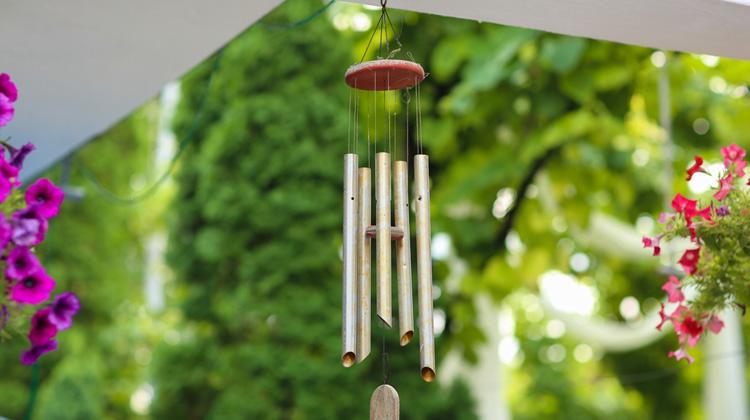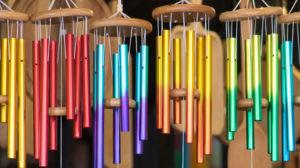As you unwind in your lounger in the patio on a sweltering summer day, you gaze at the puffy, white mists that coast over the dark blue sky. The Sun warms your skin, and you trust that a light breeze will go along to give some cooling help.
As a breeze, at last, starts to blow, you enjoy the cool touch it leaves on your skin. Your skin isn’t the solo thing getting a charge out of the breeze, however.
Your ears get the sweet hints of notes skimming on the breeze. Someplace close-by the breeze is playing an instrument assembled only for it.
What is that? A wind chime!

Wind chimes are made for open-air embellishments that maximize with the melodic instruments played by the breeze. Most wind chimes include containers of changing lengths suspended around from a stage by strings or wires.
At the time when the breeze blows, the cylinders meet by chance an article in the middle, called a clapper, and against each other. Because of it, the clash makes vibrations that venture to every part of the length of the cylinders, delivering sound waves at specific pitches relying on the length of the cylinder and what material they’re produced using.
Aluminum and copper, and wood are used to make wind chimes. Numerous different materials can likewise be utilized to make a deep tone wind chime with one of a kind sounds, including glass, bamboo, seashells, and bits of stoneware.
As a rule, the bigger and longer the cylinders are, the lower and more profound the sounds will be. Short, tight pipes will, in general, produce higher pitches. Aluminum wind rings will, in general, give the longest and most intense sounds.
Metal and wooden breeze chimes made with explicitly measured pipes can be tuned to specific notes. Wind rings made out of seashells or glass, then again, can’t be tuned to specific notes and may deliver a scope of sounds from lovely tinkling to loud crashing.
A lot of different types of metal are used for making wind chimes for deep tone. Copper or brass would be quite expensive for you. So. you can decide to go with the steel electrical conduit. You can thus, get your desired deep tone wind chime without spending extra bucks. Here, in this post, I’m going to share some formulas to make deep tone wind chime at home.
How to Make Deep Tone Wind Chimes Step By Step

Step 1: Determining Size and Design
To begin with, choose the general size (stature) for your chime set. Choices incorporate four stature classes dependent on the octave chose for the C9 Chord (C2, C3, C4 or C5). Space allowing, the more drawn out the ring tube, the lower and more extravagant the sound. Collect a design from any source with a completed drawing. There are plenty of designs on that.
Step 2: Purchasing the Necessary Stuff
From your choice in stage one, buy the required number of one inch outside distance across aluminum chrome plated shower pole tubing and other stuff (e.g. eyelet, drill, and others) at your nearby home improvement store.
Step 3: Cutting the Tube
Slice the tubing to length utilizing the outline you collected. Use care to build up the right length. Cut somewhat long, around 1/8 inch, and document or pound to the last measurement. De-burr the finishes to expel every sharp edge.
Step 4: Drill to Hang Pipes
Drill a 1/8 inches or 3/16 inches gaps (estimate controlled by helpline) at the hang point utilizing the hang-point estimation in the outline you have chosen. The hang point remove is estimated from the end.
Utilizing a boring tool bigger than the gap, place the bit outwardly of the gap and delicately pivot by hand. This is common enough to de-burr the outside gap.
Step 5: De-Burr the Within Helping Gap
De-burr within help gap. Initially, utilizing a round or half-round document, expel the burr from inside the pipe. Completion of the undertaking by utilizing a segment of coat holder wire with a little curve at the far end. Spot the wire in a drill and supplement the bowed end through the gap. As you pivot the wire, delicately pull back on the drill and the bowed wire will twist around any inside burr.
Step 6: Build the Support Plate
Prepare the supporting plate to hang pipes, it might be starlike, round or any shape you like. Finalize a drawing before preparing it. Select material for the top help plate and striker that has great climate sturdiness like red cedar, white cedar, treated wood or built timber.
Additionally, inventive materials may incorporate a disposed of nylon or plastic cutting board, brightening metal or plastic plates, channels or different amazements found at bug markets.
Step 7: Outline the Top Supporting Plate
Draw and cut on a hover with a span of 3 1/2 inches (89 mm). This is the outside distance across for the plate.
Draw a second hover with a span of 3 ¼ inches (83 mm). Alter a compass to precisely 3 13/16 inches (97 mm). Starting at any irregular point on the 3 ¼ inch sweep circle and walk the compass in the two headings, making an imprint each 3 13/16 inch. Moving the compass in the two headings from the begin lessens estimation blunder. This will recognize the inside area for every one of the 5 rings.
In case you’re utilizing a solitary line from the focal point of the pipe to hang the ring, utilize the red specks for finding their help snare. Then again, in case you’re utilizing two lines outwardly of the ring for help, utilize the blue dabs to find their help gaps or snares.
The top help circle can be hung utilizing a solitary point mount or a 3- point mount. The single point mount utilizes an aluminum turnbuckle or steel screw eye as appeared as follows. To find the imprints for a 3-point mount, draw a hover with a span of 3 ¼ inches (83 mm). Modify a compass to precisely 5/8 inches (143 mm). Starting at any arbitrary point on the 3 ¼ inch sweep circle, walk the compass around the circle making an imprint at all three areas. Supplement little screw eyes at every area.
Step 8: Make A Striker
Make a striker with a range of 1 ¾ inch (44 mm) from ½ to ¾ inch (12 to 16 mm) thick material. In the event that conceivable, shape the edge into a slug nose bend.
It is critical that the striker hang flat and that can be cultivated utilizing a 3/16″ or ¼” aluminum turnbuckle as its hub. Find the turnbuckle on the top side of the striker with the lower snare on the base side, as appeared as follows. The base snare interfaces with the breeze cruise. This game plan additionally functions admirably to hang the top help plate. Utilize a locking nut at the top to keep the fastener from releasing as the toll set turn in the breeze. This equivalent game plan can be practiced utilizing screw eyes.
Build a breeze cruise around 4 to 6 crawls in size from slender material around 1/8 inch thick or less. Drill a little gap at the corner to associate the striker line.
Tie a bond on top of it at the opening of the toll. It’s critical to tie this bunch as near within the cylinder as you can. This bunch will focus the line in the cylinder and keep it from contacting the finish of the cylinder, which would stifle or terminate the chime sound.
The life span for a chime is a significant issue and cautious thoughtfulness regarding the helplines and through gaps ought to be considered. Frequent wind changes and UV light can rapidly break down helplines.
Step 9: Metallic and Non-metallic Helpline
Metallic helpline: Meager wire, beautifying chain (zinc plated, metal plated, or painted), 1/32 or/16 inches tempered steel link (rust proof), little airplane control line link. In the event that you’re utilizing the middle circle strategy for help, at that point append the line to a little snare on the underside of the help plate.
Nonmetallic helpline: Ensure the line is UV safe. Decisions incorporate angling line (either 80 pounds interlaced or 30-50 pounds monofilament), meshed nylon line, twisted plumb line, plaited Dacron kite line, Venetian visually impaired line, string trimmer/weed eater line (065 inches), shade line and meshed electrical channel pull line.
Step 10: Chime design (you are almost done)
A round striker will ordinarily strike one ring at any given moment and can all the while striking two chimes. To upgrade deep tone, place broadly isolated notes alongside one another. For instance, to one side are area proposals for sequencing, with ring number 1 as the most limited and 5 as the longest.
Interface the striker to the base of the help plate, situating it to rest around 1 to 3 creeps over the most limited ring.
Interface the breeze sail to the base of the striker situating it to hang around six inches or more underneath the longest chime.
After you hang the ring set in your most loved area and in view of your nearby wind conditions, you may find that you are not totally happy with the execution of the set.
Since wind conditions fluctuate from area to area, don’t hesitate to alter the size or potentially weight of the breeze sail to create the ideal sound. I regularly find that another structure requires a few changes after the underlying plan. In the event that you live in a solid breeze territory and the tolls are playing excessively, and changing the size and weight of the sail did not peaceful them down as you needed. Attempt marginally decreasing the breadth of the striker to make up for solid breezes. Hope, you got your deep tone wind chime ready to fill your heart.
All Said
Today, wind chimes are well-known embellishments in especially garden and yards all around the globe. It adds a fresh trend in your home and office decoration. It comes with the power to ease and remove your boredom with the melodic tone it produces. With a careful hand, you can own such an amusing wind chime to add extra beauty to your decoration.
Now you know how to make deep tone wind chimes. With perfect making and installation at a proper place, you can widen your relaxation and happiness. Thoroughly read the post, apply all the steps and produce your lovely wind chime. Enjoy it now!
This is Autem Decker. Main Author of ‘TheHomeDigs‘. You may not find her on the list of top 10 contemporary Canadian interior designers, but everyone who knows her says she was born to be an interior designer.
She makes her plan in her head and draws them in her years-old diary with a note in the corner. The way she plays with color and shape amazes us.
Connect Her On – Twitter
1 thought on “How to Make Deep Tone Wind Chimes | Step by Step Guide”